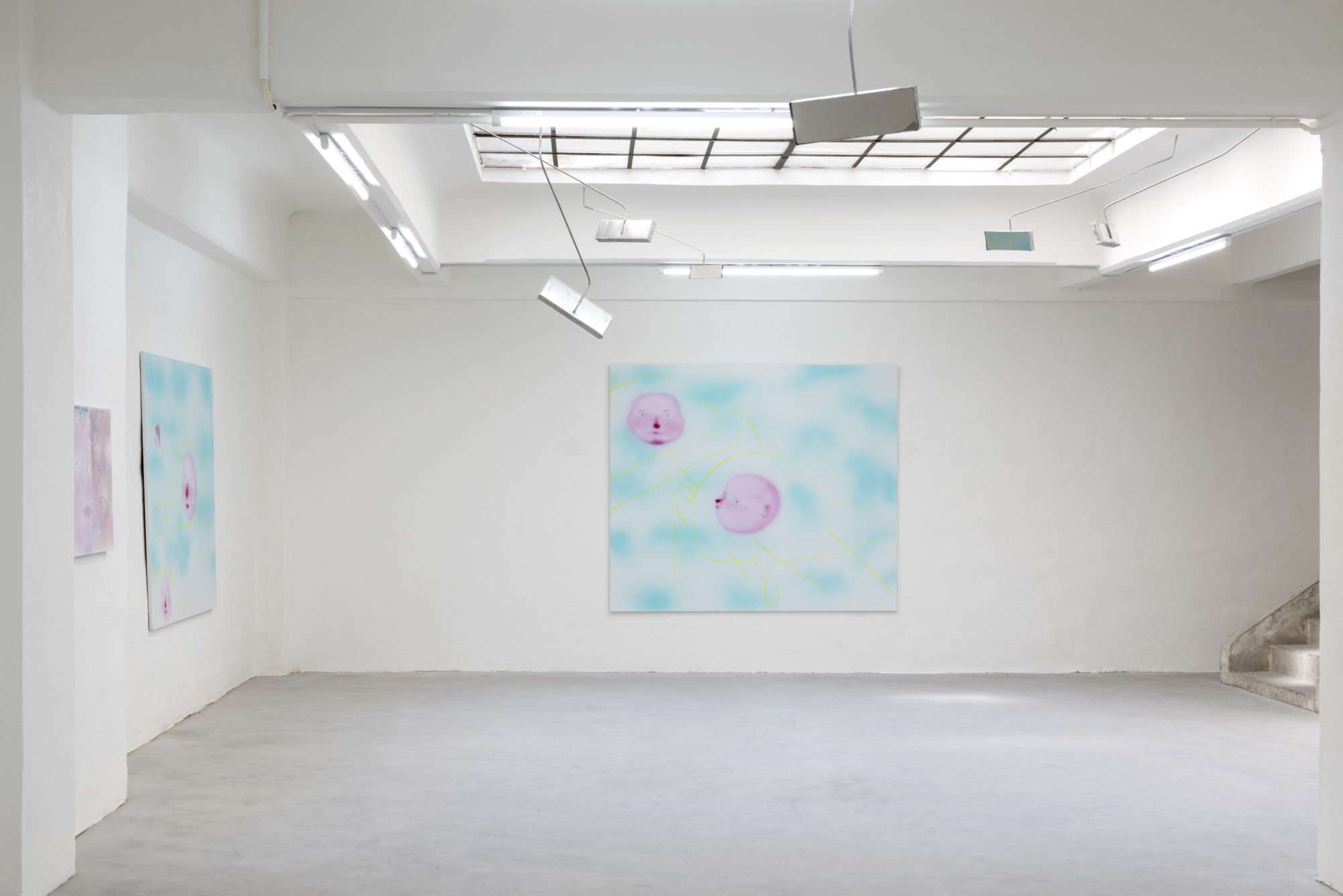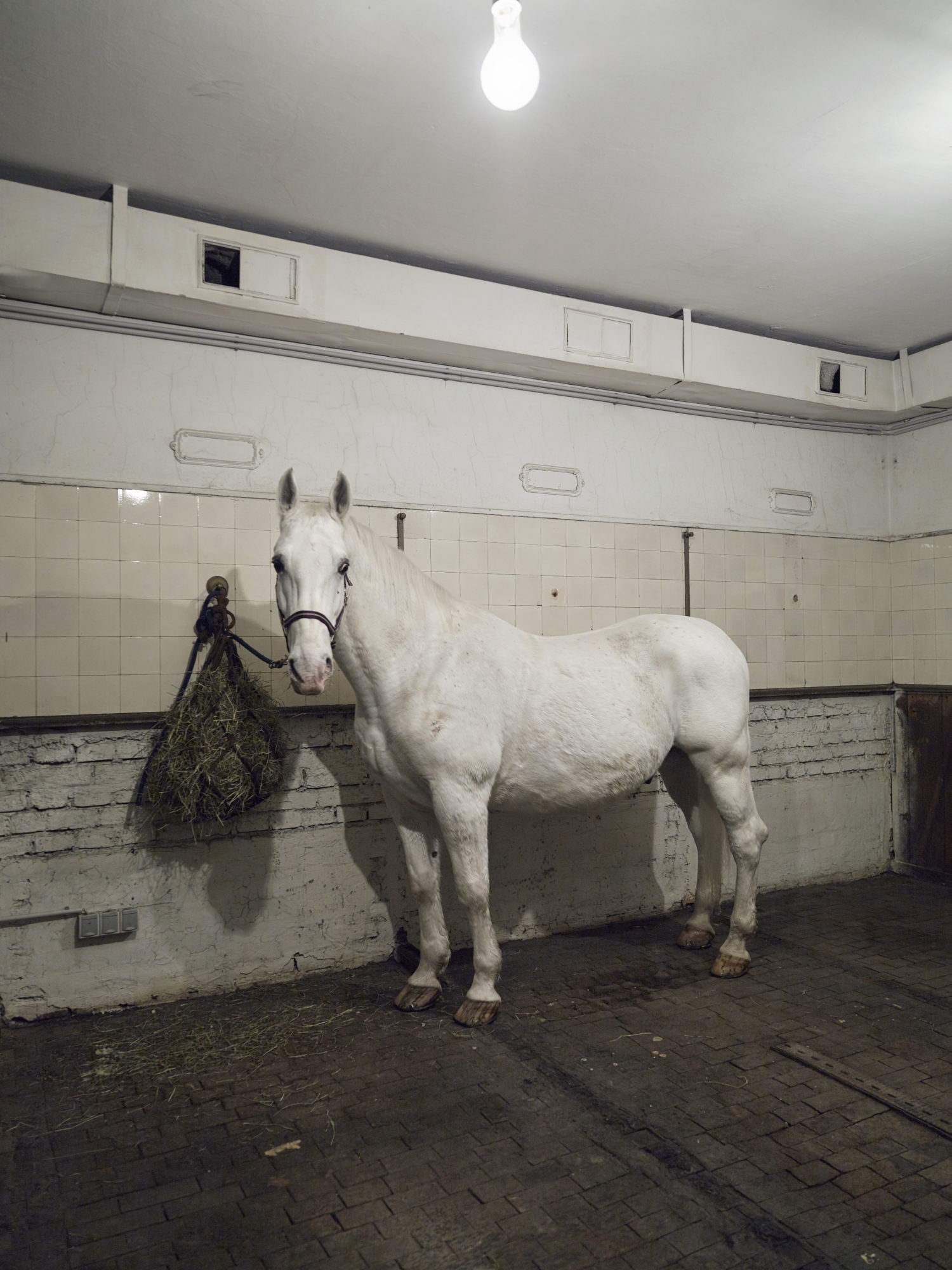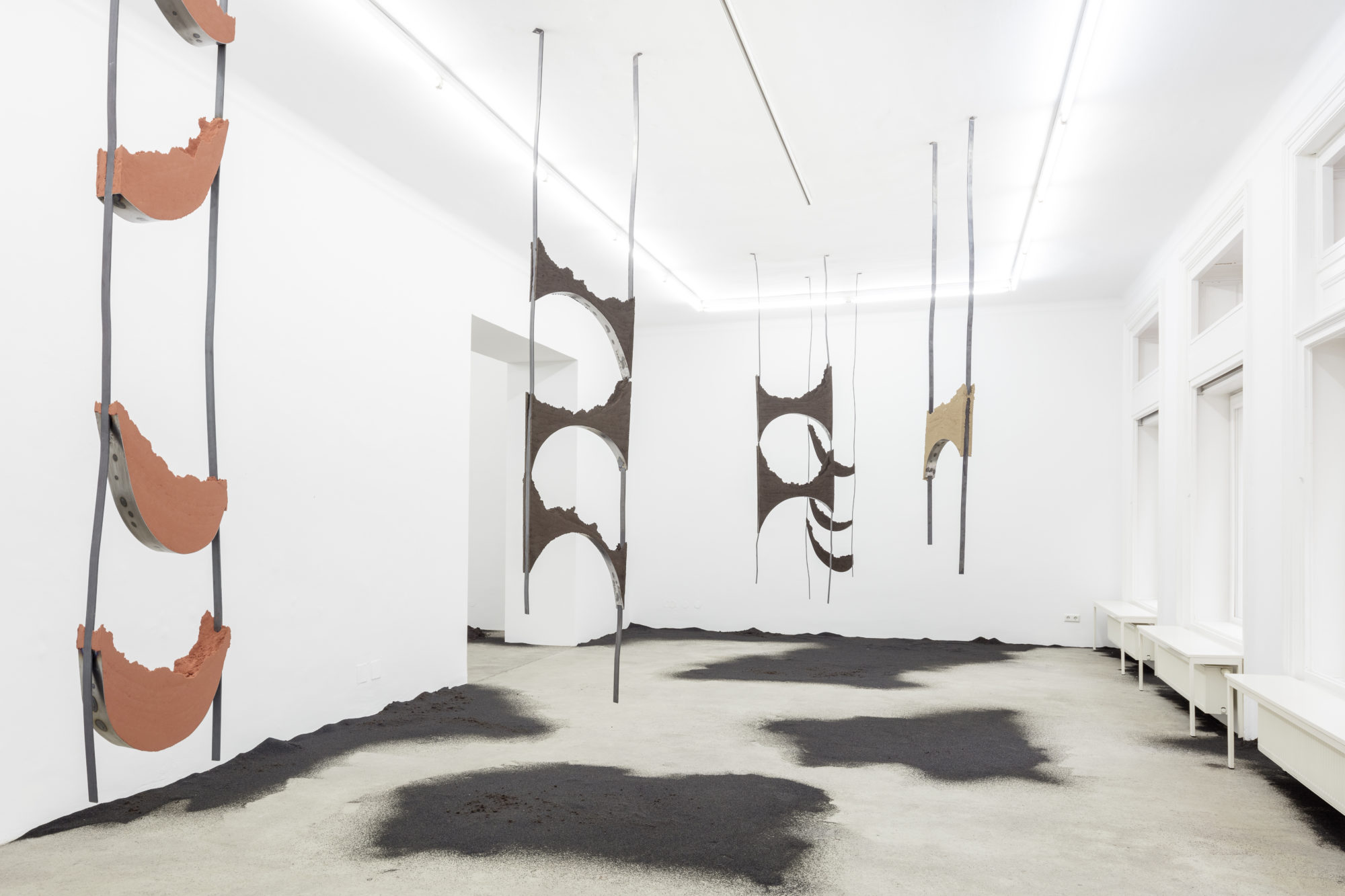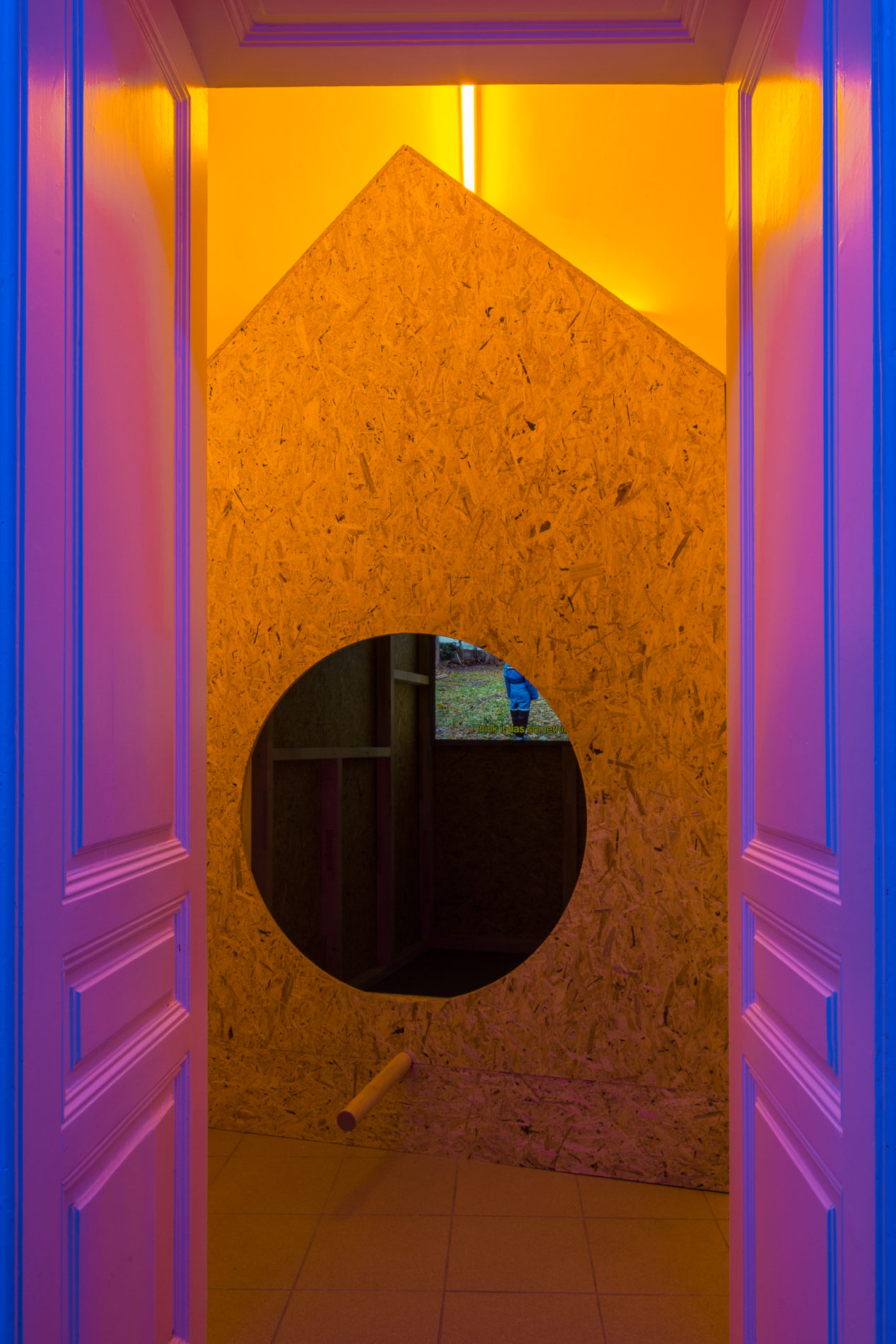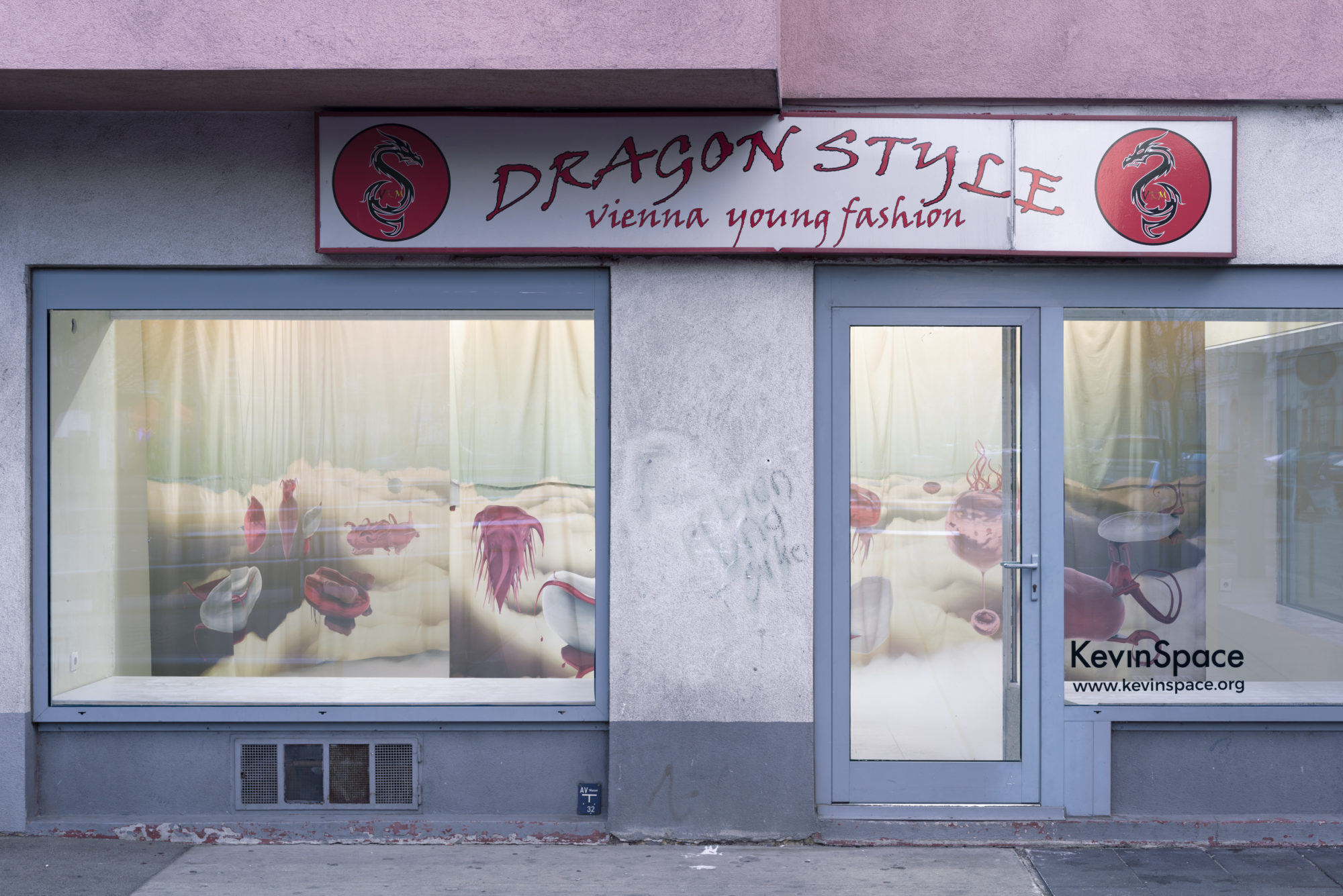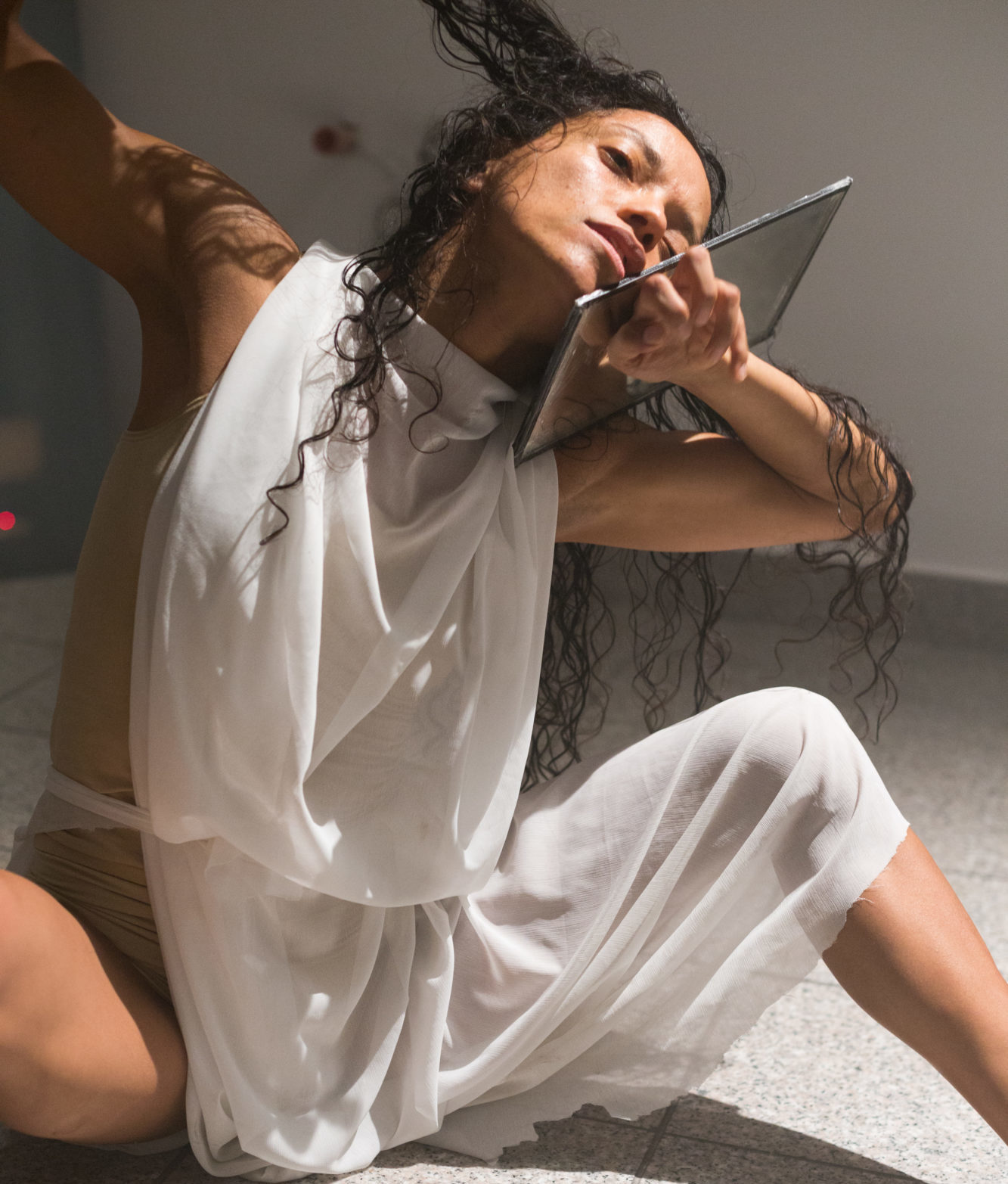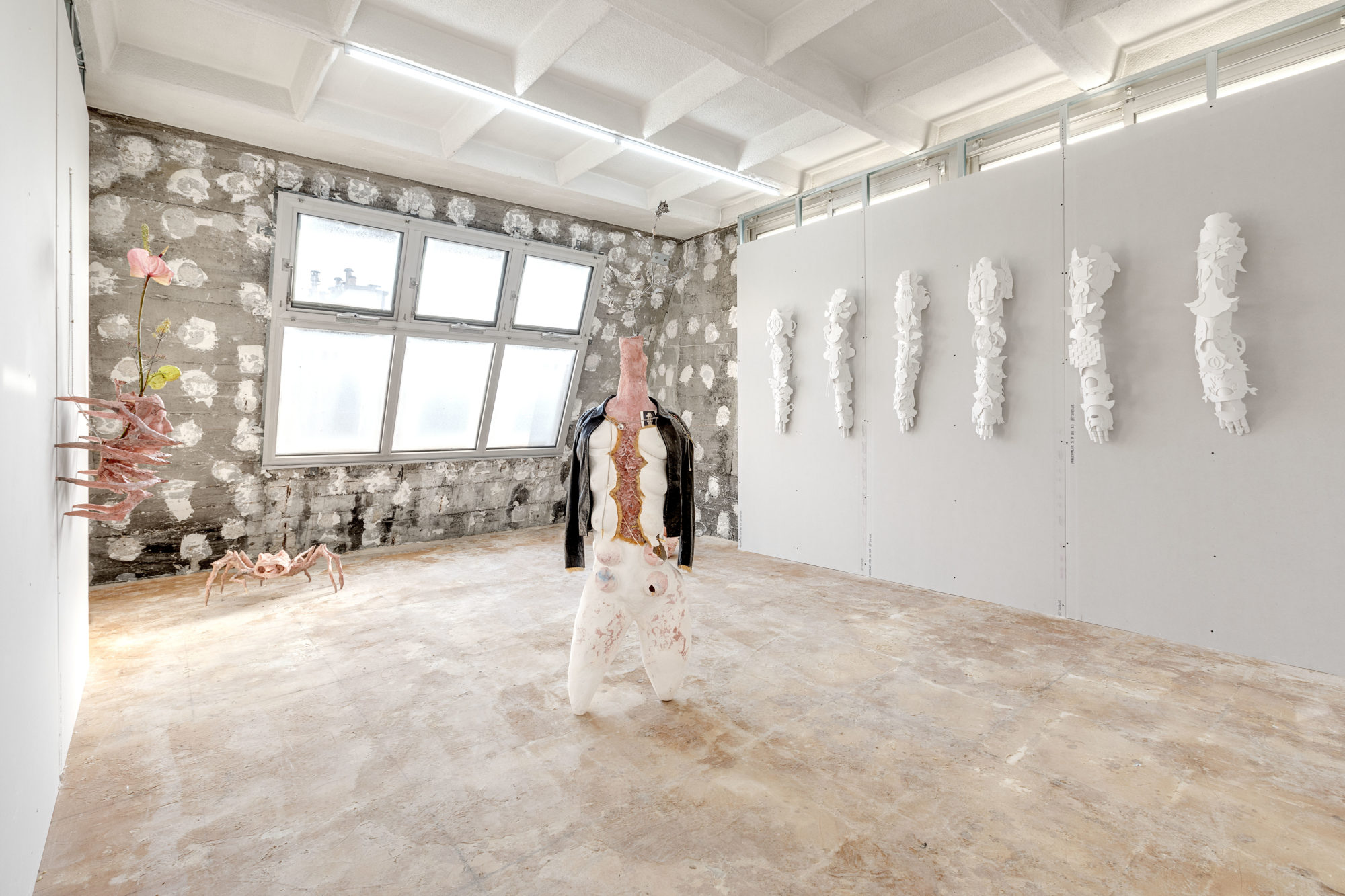
Louve, installation view at Paris Internationale, 2017 [photo: Romain Darnaud; courtesy of Nils Alix-Tabeling, Matthieu Haberard, and Gianni Manhattan, Vienna]
Viva Vienna
Share:
Vienna is dripping in cultural history; looking backwards from the 20th century, the city can claim to have birthed and incubated the rebellion of Actionism, the humor of Franz West, the radiant symbolism of Gustav Klimt and the Vienna Secession, to say nothing of the innovation of Haydn, Mozart, Wittgenstein, and Loos. It is the intellectual home of Sigmund Freud, without whom the 20th century and its most radical artistic expressions might have looked very different. Today, however, it is rarely thought of as an art world capital (and it is not the only old world cultural hub to have ostensibly ceded that title over the years). Yet its position as a both affordable and cultured city, its location at the heart of Europe, and an apparent renewed investment from arts institutions and communities are factors that make it an enticing base for student and emerging artists, writers, and curators, and an attractive scene for new galleries and project spaces who are refreshing the city’s cultural landscape through the energy and engagement of their experimental programs. Featured here are five such spaces, whose founders discuss the past, present, and future of their projects, of Vienna, and of art in the world.
GALLERY: Gianni Manhattan
Speaking / Laura Windhager, Founder
I come from a background in science and originally studied molecular biology. When I finished my undergraduate degree, I enrolled into a course in the history of art, followed by a master’s in contemporary art theory with Mark Fisher and Irit Rogoff at Goldsmiths, London. It was there that my interest in notions of post-work, digital labor, [and] unproductivity in relation to artistic practices started. I soon started my PhD in philosophy at the Academy of Fine Arts in Vienna, where I looked into sustainable working models between artists and institutions. To help fund my studies, I started working in a gallery—[Galerie] Hubert Winter, in Vienna—and it was there that I became motivated to re-evaluate the model of a gallery, to think it away from its (centrally, but not solely) commercial ambitions.
By the time I had wrapped my head around the fact that I wanted to start something, to contribute a platform for young and emerging artists, some brilliant project spaces such as Kevin Space, MAUVE, and Pina, and young galleries such as [Galerie] Nathalie Halgand, had opened. I was undecided for quite some time [about] whether to run a project space or a gallery – what won me towards the latter is that I wanted to work with artists on a long-term basis, [to have] the chance to grow together, to really and deeply engage with one another’s thinking and way of working.
My partner and I found this incredible space on the Gumtree of Austria. It’s an old print shop that we spent months renovating, but the rent is very low and the space is very big. There is this term in German called a Programmgalerie—a “program gallery.” It’s a concept I am intrigued by and have adhered to because there is definitely a red thread connecting the artists I work with: … a shared concern for the world we live in, [and in] questions surrounding the environment, sexuality and gender, language, marginalization, and the nonlinearity of history. What combines all their practices is a need to find better metaphors, more openness, and better questions.
It is important to state that there is no “art capital” in the world at the moment. Vienna is just a place that has been dormant for a long time and is now being awoken. Local collectors are important, but digital representation will continue to expand in the future, so I believe that in order to survive as a young gallery, finding sustainable solutions and a close international network is imperative.
Within two years, a young art scene has emerged where there hasn’t been one in almost 10 years, and a lot of the initiatives are spearheaded by women, which is great. With these openings [occurring] within such a short timespan, I think it created a momentum, a dynamic that the city has been missing. I also see a lot of collaborations happening between fellow gallerists and project spaces. I think most young art professionals are aware of how difficult times are at the moment, and there is a very sincere understanding of the need to collaborate, to work together.
The future is really exciting and there are a lot of opportunities to present work to a larger audience. But it would be naive to forget that there will also be lots of battles ahead, especially with the new political landscapes spreading across Europe. The future will also be a moment to work collaboratively and to reinforce the importance of cultural activity and critical thinking.
You are underground, installation view, 2017, [photo: Simon Veres; courtesy of Simon Mathers and Gianni Manhattan, Vienna]
GALLERY: Guimarães
Speaking / Hugo Canoilas, Christoph Meier, Nicola Pecoraro, artists and founders
Nicola: We shared a studio to begin with so we have this kind of ongoing conversation, sometimes quotidian, and sometimes not. This obviously involves talking about artworks and ways of dealing with exhibitions. Initially we wanted to start a band and call the band Guimarães. That was in talks for two years, and we thought, “let’s look for a rehearsal space.” We stumbled upon stables on a classifieds website, saw the space and realized we couldn’t really rehearse in it. So we started making exhibitions. It’s the same as jamming, in a way: it has to be something that we ultimately take pleasure in doing, and we don’t feel like it’s something that is necessarily a career move.
We had the first show in December 2016. We showed a 12-year-old Viennese horse: a fat, wide Lipizzaner they would also show in the Spanish horse-riding school, one of the biggest tourist attractions in town. We wanted to link to the space’s previous function as stables. Downstairs there was only one work, by Luisa Gardini, an [Italian] artist born in 1935. The work was very strong but also very sensible and humble.
Hugo: We start by showing images to each other … and then there’s a lot of sense of humor, sarcasm. The project has more positive desire than criticism. I think the fact that we are artists [means] we work with other artists with the same energy. We are talking about things with the same nature of discourse. We are bringing people in who have never exhibited in the city, and we have been working hard to introduce these artists to other artists, curators, writers, galleries, and museums and that has been very [productive].
Christoph: I think we were tired of the fact that in Vienna people show themselves. The same gangs or crews… this stupid Viennese expression, “off-space.” What was pretty clear from the beginning was that we would not represent the local scene. Manuel Ocampo was the second show. We had music running through the show … a soundtrack that we lifted from the nearby Japanese restaurant called Kuishimbo. It has a very classical, good taste jazz playlist. Ocampo’s paintings can be quite crude, although they are also exquisite, [so] it was a very interesting match. We manage shows about twice a year. They last for about two months.
Nicola: It’s only by appointment, so it’s very likely you [will] get a sort of guided tour by one of us. Hopefully it’s not imposed. We’re there for information. It’s quite bespoke in a way. We try to find alternative ways to support ourselves, and a certain freedom that comes out of it. Vienna has nothing between these big players and these small players. We really want to place ourselves in that gap.
Hugo: The city is slow, to the point that it feels you have more time for yourself. You read more. You write more. You think more. You are not so much in permanent reaction, like [you are when you’re living] in London. Then there’s an almost Socialist tendency in the scene, where you try to help your peers. If you say you’re looking for a studio, someone invites you in. Maybe someone needs a job and people try to help. There’s a much better sense of community than in [our native] Portugal, for instance.
Luisa Gardini & Felix, installation view, 2017, [photo: Gregor Titze; courtesy of Luisa Gardini and Guimarães, Vienna]
GALLERY: Sophie Tappeiner
Speaking / Sophie Tappeiner, gallerist
I studied art history and business, then I worked at one of the well-known auction houses in London. An artist friend of mine and I developed a side project, which made me realize that I found more personal collaborations much more rewarding. I eventually moved back to Vienna, where I am from, and was offered a project space. I observed a need for young galleries in an increasingly vibrant younger scene—Emanuel Layr and Andreas Huber were the youngest gallerists [at the time, and both] opened their spaces more than a decade ago. There were all these off-spaces and project spaces, some of them working internationally, others working just with their friends or showing local art students. But no one had actually committed to representing artists, to doing an independent space that doesn’t rely on public funding. A commercial space.
I never thought that I was going to run my own gallery. It was just something that all of a sudden seemed like a natural next step. It took me actually quite a while to find a suitable space. Hans Schabus, an Austrian artist who teaches at die Angewandte, used to host an artist lecture series in the space … [When I went to one by]Anna-Sophie Berger in 2015, I said to Hans, “I love the atmosphere in your space.” And he remembered. When he moved out, he informed me [that it was] available. I had to negotiate for a year to actually get it, because it was too expensive. I opened in May 2017.
I think accessibility was quite important to me—the Viennese don’t venture out that much. Being close to the other galleries was quite important. The gallery aims, among others, are to foster strong relationships and a sense of community for everyone involved, supporting one another, developing and realizing ideas together, learning from each other, contributing to the world we live in and building something of relevance that resonates not only within the immediate community or scene but that goes beyond it and is lasting. I hope the physical gallery space can be a platform for experimentation, encounter, interaction, and dialogue.
The program shows Austrian and international artists. It’s something that’s very important to me, as the art world has become global. So far, of the four solo shows, two were by artists living and working in Austria (Angelika Loderer and Liesl Raff). Sophie Jung is from Luxembourg, and works and lives between Basel and London; Sophie Reinhold lives and works in Berlin. I will be showing Sophie Thun, a young artist who studied painting with Daniel Richter and photography with Martin Guttman. After Sophie, Lone Haugaard Madsen will be showing. Her practice is rooted in a profound engagement with production and exhibition spaces.
Vienna has a lot to offer in terms of living standards: rents are affordable, the city is beautiful, there is a huge cultural heritage, and the city boasts a range of museums, theaters, opera, etc. You can quickly get to the countryside, and geographically it’s easy to get around Europe. In recent years the city has seen an increase in young entrepreneurs and more independent shops, initiatives, and restaurants have opened. Vienna [also] has these almost anachronistic places—like old coffeeshops and other random things— and one wonders how they are still in operation. I think for the size of the city there’s really a lot going on. What I enjoy is that it is becoming increasingly international, which to me is very refreshing and enriching.
Angelika Loderer, Quiet Fonts, installation view at Sophie Tappeiner, 2017 [photo: kunst-dokumentation.com; courtesy of the artist and Sophie Tappeiner, Vienna]
GALLERY: Vin Vin
Speaking / Vincenzo Della Corte, founder
I think Vienna is an extraordinary city in relation to the creative power that has always characterized it. Everything seems to refer to the past, to the tradition … this is an ability that Viennese people have, to enhance their heritage. At a first glance, many things look very static, and a lot seems to be oriented exclusively towards tradition: the tourist attractions, the perpetuation of certain customs, the horse-drawn vehicles. But if one looks deeper, Vienna has always been completely the opposite—an enormously progressive city, one of the most cutting-edge capitals in Europe. Once a German friend of mine defined Vienna as a “bon bon” city, referring to its shiny look: everything very precise, the streets clean, the buildings constantly on restoration, et cetera. Actually Vienna is punk deeply inside.
In 2008, as I was studying orchestral conducting, I started … doing studio visits with young artists, visiting art fairs all over the Europe, and organizing exhibitions in an intimate, domestic form. This activity became so intense that at a certain point I felt the need to open a platform that could contribute to the very complex and articulated art system discourse, and could satisfy my need to be part of a community.
I looked for a space. I rented a basement in the first district, and I started with the first exhibition in March 2016. My approach is very intuitive but also very structured in relation to all the pondering to do … when I visit an artist at the studio, when I consider a collaboration, when I interact with the public, when I am dealing with professionals. It is an approach driven by a huge amount of enthusiasm, too. I hope that this is perceptible, because I really believe that enthusiasm is contagious. Enthusiasm is pure fuel, and generates context, contents, and structure.
I perceive every new opening as a new, amazing highlight. Julian Turner, who exhibited in March 2016, Vin Vin’s very first show, was awarded the Kapsch Contemporary Art Prize, with a solo exhibition at mumok in November [2017]. … I remember still with great excitement the amazing reaction of the public to the work of Dino Zrnec, presented with a solo booth at miart, Milan, 2017. We presented “crack paintings,” non-replicable works realized with a very complex process of applying the color from the back of the canvas, … articulated through two main elements: the artist’s intention, and unpredictability. We have already started an intense dialogue concerning the contents of his next exhibition at Vin Vin.
The Vienna scene is very articulated, with a huge amount of museums, galleries, spaces, and many good Austrian and international artists living here. The affordable rents and the quality of life still allow for a certain agility and exibility. There is at the moment a very interconnected and positive attitude within the art scene in Vienna. There is a constructive dialogue among the young entities; we are working on it.
Issues might arise if there are funding cuts. There is an Aristotle quote I am particularly fond of: “All who have meditated on the art of governing mankind have been convinced that the fate of countries depends on the education of youth.” We could continue this wonderful thought by stating that the fate of countries depends also on the attention that their governments dedicate to arts and culture!
Line K Meyer, CRYPTOMOM tuning, installation view at Vin Vin, 2017 [photo: Flavio Palasciano; courtesy of the artist and Vin Vin, Vienna]
GALLERY: Kevin Space
Speaking / Fanny Hauser, Carolina Nöbauer, Franziska Sophie Wildförster, and Denise Helene Sumi, co-founders
Franziska: We know each other from university. I met Caro four, five years ago in a seminar with Sebastian Egenhofer. We were doing our bachelor’s in art history; same with Denise. Two years ago, when we started the space, it was a very different landscape here. We had great contemporary cultural institutions, but we didn’t really have something like a Kunstverein. Kevin Space is born out of the idea to inhabit this gap, with an open space that has an ambitious and discursive program.
Fanny: On a personal level, we were all interning, or working in institutions in assistant positions, except Franziska who was a curator. It was time to start something on our own.
Franziska: This is our third location in two years. We really started from nothing. We didn’t have funding. We didn’t have a space. Since September 2016, we’ve been in this great space in the second district at Volkertmarkt, but it took a really long time to find it. There’s a lot of empty and available spaces here in Vienna, but it’s really hard to get ahold of them. We tried to get this for months. We were lucky. We always do new, on-site productions, usually commissions that are responding to the space itself, which is a challenge.
Carolina: We go through all the steps of realizing an exhibition together, which is actually more work, but for me it’s also a more exciting experience. It’s just more fun [if] we’re all involved throughout the whole process of each show.
Franziska: The program is discursive. It is often related to questions of gender and queerness, … questions of identity. The artists invited often examine the production, distribution, and consumption of knowledge, and systems of governance on the body and experience. We are all keen on hosting public and ephemeral programs, such as talks and performances, and to try to open up the space to diverse publics.
Fanny: The gallery scene in Vienna is dominated by women. There is a group of female gallerists that started here in the very male dominated art world of the 80s and 90s and [their galleries] are still among the most relevant ones in the city: pioneers Rosemarie Schwarzwälder, Heike Curtze, Christine König, Ursula Krinzinger, Silvia Steinek, and, later, Gabriele Senn and Kerstin Engholm. In the past year, a new generation of young female gallerists opened their doors as well: Sophie Tappeiner, Nathalie Halgand, Lisa Kandlhofer, and Gianni Manhattan.
Carolina: There are quite a few female collectives doing important work: school has been doing a great programme since they started in 2011; VBKÖ (Vereinigung bildender Künstlerinnen Österreichs) is almost an institution. Mes Meufs are kind of nomadic but put on great shows in different venues; [there is a] hacker collective and small art space called Mz Baltazar’s Laboratory, and the recently started GOMO. I think there’s also a strong sort of solidarity among women in the art world at the moment here in Vienna.
Fanny: A few years ago Vienna was not really on peoples’ radar. Then a lot of young people from other cities moved here—the rents in Berlin are now higher than in Vienna, I guess. There are more young people coming in, starting spaces. You have organic markets everywhere, open air parties during the daytime at the Danube. I was born and raised in Vienna, and 10 years ago, that wouldn’t happen on this scale.
Franziska: A lot of people are worried about what is going to happen to [public] funding for culture and contemporary art. Vienna has always been very comfortable in terms of funding. [Recently, some] people that have always gotten funding from the main federal have been denied their funding. We’re going to see what’s going to happen to Vienna as a cultural place. The situation has sparked a sense of collectivity between the many independent art spaces. There is the aim to take action, together.
Venus City, installation view at Kevin Space, 2016 [photo: Georg Petermichl; courtesy of Marianne Vlaschits and Kevin Space, Vienna]
Kandis Williams, Semiosis Cataracts, 2017, performed by Lina Venegas [photo: Laura Schaeffer; courtesy of the artist and Kevin Space, Vienna]
Glossary
GUMTREE (website)
“The first site for free classifieds ads in the UK,” where users can “[b]uy and sell items, cars, properties, and find or offer jobs in [their] area.”
OFF-SPACE (slang)
An artist-run space, especially in Vienna.
MUMOK (proper noun)
Abbreviated from “Museum moderner Kunst Stiftung Ludwig Wien” (“Museum of modern art of the Ludwig collection of Vienna”), mumok is the largest museum in Central Europe exhibiting art “since modernism.” According to its mission, the museum “makes the various aspects of the international and Austrian avant-garde accessible to everyone interested in the arts.”
KUNSTVEREIN (noun)
Term used in German-speaking regions meaning “art association,” often a non-profit, non-collecting contemporary art space offering exhibitions and public programs.
PROGRAMMGALERIE (noun)
In English, “program gallery” or “programmed gallery,” designating a commercial art exhibition space, in which exhibited works are for sale but the exhibitions are nonetheless curated with a broader discourse or idea in mind beyond the selling of the works on view.
DIE ANGEWANDTE (proper noun) Short-hand for the Universität für angewandte Kunst Wien, in English, the University of Applied Arts, Vienna.
